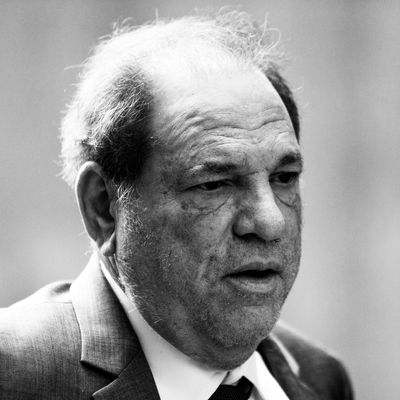
As New York prepared to publish this week’s look at the coming trial of Harvey Weinstein, along with a portfolio of women who have made allegations against him, I reached out to his current publicist, Juda Engelmayer, for comment. After some back and forth, Engelmayer sent me a 57-page PowerPoint presentation, dated December 2, entitled “The Proper Narrative for Addressing the Harvey Weinstein Case.”
The document presents oppo research about Weinstein’s accusers, including text messages and photographs, with the goal of vindicating him in the press. (The email from Engelmayer said only “just for your review”; at no point did we ever put any part of our communication off the record.) Asked about its authorship, Engelmayer said it had been written by “a research team prior to me.” The document also refers to “the detailed refutations we have described in this meeting.” What meeting and with whom? “The meeting is really any room in which these slides were presented,” Engelmeyer replied mysteriously. “Stakeholders of various sorts.” I’ve since become aware of an earlier version dated this past July.
The document frequently shifts in tone, voice, font size, and color, and seems to include some draft notes (“[ask HW: did they actually meet? Seems possible]”) and strike-throughs. It argues that some women’s allegations of sexual abuse were the result of “strong and repeated suggestions from others,” including press reports and activists. “Given the pressures that many women today feel from the various laudatory movements against workplace imbalances, the notion that consensual relations are being reinterpreted cannot be overlooked,” it says on page 10.
The document claims there is “no objective support” for any of the women’s claims because there were no witnesses and “no physical injuries — even scratches”; current rape law requires nothing of the sort and hasn’t for at least a half century. On page 27, in a subsection entitled “5 Illustrations Why HW’s Accusers are not Credible,” it suggests that one woman opening her door to Weinstein “in her nightgown suggests that this was consensual, and that her current version is revisionist. It is not the nightgown per se that is troublesome but its presence in a situation where, according to [the woman] herself, she had strong reason to be wary.”
Some of the women named are famous actresses. Most of the other material included on them would be familiar from the campaigns waged to prevent the New York Times and The New Yorker from publishing harassment and assault allegations against Weinstein: photos of them “smiling, flirting” with Weinstein in public or at publicity events after the incident in question (the presentation includes the photos, complete with Getty Images watermark) or continuing to work with the powerful producer after the incident allegedly took place. But some of the material, accusing women of making allegations to further their careers, is new. The document includes a screenshot of a text exchange between Weinstein himself and a “respected witness” (Engelmayer: “a prominent person whom will not be mentioned”) about one of the women accusing him of rape. “The rape version got her an agent at CAA so there’s that,” writes the “respected witness.” Even after stories about him sparked a cultural reckoning, and having cycled through multiple defense attorneys and PR firms, Weinstein’s chosen defense remains offense.
The fourth “illustration” on the list is the unnamed woman in the New York criminal case, one of two whose cases could send Weinstein to prison. The material seeking to refute her charges is most likely a preview of Weinstein’s defense team — that she allegedly kept in warm contact with him, or asked him for favors, and that emails will, in the words of the presentation, “show a long term, loving, consensual relationship.”
“We hope you will consider the fact that a large number of women with whom HW worked on a regular basis reported nothing close to a sexual assault,” it continues, adding that after Meryl Streep said Weinstein was “respectful with me,” she “was critiqued so much she had to make some bland statement about ‘power imbalance in our own industry.’”
There is also a list of women who, the PR team says, have described unwanted sexual advances but haven’t explicitly claimed they were blacklisted for saying no. (Retaliation isn’t required to establish sexual harassment.) The document then lists women who have said they were retaliated against but includes bullet points from press reports to argue any career consequences were their own doing for, for example, “verbally assaulting a makeup artist because of ‘dirty brushes.’” Weinstein, of course, has never denied his own temper — before his downfall, it was brandished as a mark of brassy authenticity.
In a section entitled “Who Harvey Weinstein is,” it mentions that Weinstein has organized “two extraordinary benefit concerts” and raised $500 million for charity. Examples of his good deeds include “for a famous actor’s girlfriend, HW arranged lifesaving treatment,” “producing socially important commercial failures,” such as films about sexual assault and LGBT people. On page 40, it defends Weinstein for having a “huge heart.”





